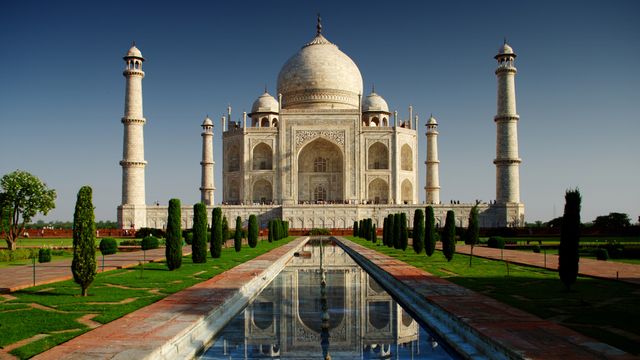9.2.6
Emerging Powers - India
India - Economic, Political and Military
India - Economic, Political and Military
India is the second-largest English speaking nation in the world and is the world's largest democracy.


Economic characteristics
Economic characteristics
- India is the second largest English-speaking nation in the world (after America) which means it has seen economic growth through the growth of its services sector.
- Many global TNCs outsource their services in IT to India. BT has call centres in Bangalore.
- India also has universities with global reputations that will allow it to continue being regarded as a well-educated nation.
- India is expected to grow its economy by 7-8% up to 2020.
- However, poverty is still high and sanitation is often poor, with many people not using toilets across India.


Political characteristics
Political characteristics
- India is the world’s largest democracy and is politically stable.
- It has over 800 million voters and its youthful population means that 2.7% of those were aged 18-19 years old.
- It was a founding member of the UN and maintains a role in UN peacekeeping missions.
- However, the 'caste system' treats Indians from different backgrounds differently, in a way that isn't too different to Apartheid in South Africa. People from lower castes have worse opportunities.
- Narendra Modi became Prime Minister in 2014 with an agenda to reform India and modernise its economy.


Military characteristics
Military characteristics
- Global Fire Power ranks India as the world’s 4th largest military power in terms of its weaponry.
- India has nuclear weapons.
India - Cultural, Demographic and Environmental
India - Cultural, Demographic and Environmental
India is the second-largest English speaking nation in the world and is the world's largest democracy.


Cultural characteristics
Cultural characteristics
- India has global cultural influence as the birthplace of 4 world religions (Hinduism, Buddhism, Jainism and Sikhism).
- There is still some disquiet between Hindus and Muslims in India. In 2012, 97 people died in religion-related riots.


Demographic characteristics
Demographic characteristics
-India has the world’s second largest population at 1.3 billion people.
- The ability to speak English that has helped India to grow and attracted jobs from TNCs.
- India's population doesn’t have the problems of other BRICs with an ageing population- the working population may exceed China’s by 2020.
- It has a youthful population and a fertility rate that remains above replacement level at 2.4 children per women.


Environmental characteristics
Environmental characteristics
- India is a very biodiverse country with 6% of the world’s plant and animals species.
- But, similarly to other BRICs, India has severe problems with pollution.
- It’s the world’s 3rd largest carbon emitter and has many problems with slums.
1Tectonic Processes & Hazards
1.1Tectonic Processes & Hazards
1.2Natural Disasters
1.3Natural Disaster Case Studies
1.4Trends & Patterns
2Option 2A: Glaciated Landscapes & Change
2.1Glaciated Landscapes Over Time
2.2Periglacial Landscapes
2.3Glacial Processes
2.4Glacial Landforms
3Option 2B: Coastal Landscapes & Change
3.1Coastal Landscapes
3.2Coastal Erosion & Deposition
3.3Coastal Risks
4Globalisation
4.1Globalisation
4.2Negatives of Globalisation
4.3Global Shift
4.5Culture
4.6Measuring Development
5Option 4A: Regenerating Places
5.1Types of Economies
5.2Function of Places
5.3Regeneration
5.4Regeneration Case Studies
6Option 4B: Diverse Places
6.1Population Structure
6.2Past & Present Connections
6.3Urban & Rural Spaces
6.4Diversity
6.5Urban & Rural Case Studies
6.6Case Study - Tower Hamlets
6.7Case Study - Sturton-le-Steeple
7The Water Cycle & Water Insecurity (A2 only)
7.1Hydrological Processes Global to Local
7.2Influences on the Water Cycle
7.3Water Insecurity
8The Carbon Cycle & Energy Security (A2 only)
8.1The Carbon Cycle
8.2Energy Consumption
8.3Alternative Energy
8.4Growing Demand for Resources
9Superpowers (A2 only)
9.1Superpowers
9.2Hard & Soft Power
9.2.1Hard & Soft Power
9.2.2Emerging Powers - China Rivalry
9.2.3Emerging Powers - Chinese Sources of Power
9.2.4Emerging Powers - Brazil
9.2.5Emerging Powers - Russia
9.2.6Emerging Powers - India
9.2.7Theories of Development
9.2.8Power Case Studies: Chinese One Belt One Road
9.2.9Power Case Studies: Pakistan Nuclear Arms
9.2.10Power Case Studies: OPEC
9.3IGOs, TNCs & Alliances
10Option 8A: Health & Human Rights (A2 only)
10.1Human Development
10.2Role of Governments & IGOs
10.3Human Rights
10.4Interventions
11Option 8B: Migration & Identity (A2 only)
11.1Globalisation & Migration
11.2Consequences of Migration
11.3Nation States
11.4Responses to Global Migration
Jump to other topics
1Tectonic Processes & Hazards
1.1Tectonic Processes & Hazards
1.2Natural Disasters
1.3Natural Disaster Case Studies
1.4Trends & Patterns
2Option 2A: Glaciated Landscapes & Change
2.1Glaciated Landscapes Over Time
2.2Periglacial Landscapes
2.3Glacial Processes
2.4Glacial Landforms
3Option 2B: Coastal Landscapes & Change
3.1Coastal Landscapes
3.2Coastal Erosion & Deposition
3.3Coastal Risks
4Globalisation
4.1Globalisation
4.2Negatives of Globalisation
4.3Global Shift
4.5Culture
4.6Measuring Development
5Option 4A: Regenerating Places
5.1Types of Economies
5.2Function of Places
5.3Regeneration
5.4Regeneration Case Studies
6Option 4B: Diverse Places
6.1Population Structure
6.2Past & Present Connections
6.3Urban & Rural Spaces
6.4Diversity
6.5Urban & Rural Case Studies
6.6Case Study - Tower Hamlets
6.7Case Study - Sturton-le-Steeple
7The Water Cycle & Water Insecurity (A2 only)
7.1Hydrological Processes Global to Local
7.2Influences on the Water Cycle
7.3Water Insecurity
8The Carbon Cycle & Energy Security (A2 only)
8.1The Carbon Cycle
8.2Energy Consumption
8.3Alternative Energy
8.4Growing Demand for Resources
9Superpowers (A2 only)
9.1Superpowers
9.2Hard & Soft Power
9.2.1Hard & Soft Power
9.2.2Emerging Powers - China Rivalry
9.2.3Emerging Powers - Chinese Sources of Power
9.2.4Emerging Powers - Brazil
9.2.5Emerging Powers - Russia
9.2.6Emerging Powers - India
9.2.7Theories of Development
9.2.8Power Case Studies: Chinese One Belt One Road
9.2.9Power Case Studies: Pakistan Nuclear Arms
9.2.10Power Case Studies: OPEC
9.3IGOs, TNCs & Alliances
10Option 8A: Health & Human Rights (A2 only)
10.1Human Development
10.2Role of Governments & IGOs
10.3Human Rights
10.4Interventions
11Option 8B: Migration & Identity (A2 only)
11.1Globalisation & Migration
11.2Consequences of Migration
11.3Nation States
11.4Responses to Global Migration
Unlock your full potential with Seneca Premium
Unlimited access to 10,000+ open-ended exam questions
Mini-mock exams based on your study history
Unlock 800+ premium courses & e-books